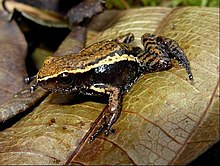
Poison dart frog is the common name of a group of frogs in the family Dendrobatidae which are native to tropical Central and South America. These species are diurnal and often have brightly colored bodies. This bright coloration is correlated with the toxicity of the species, making them aposematic. Some species of the family Dendrobatidae exhibit extremely bright coloration along with high toxicity, while others have cryptic coloration with minimal to no amount of observed toxicity. The species that have great toxicity derive this feature from their diet of ants, mites and termites. However, other species that exhibit cryptic coloration, and low to no amounts of toxicity, eat a much larger variety of prey. Many species of this family are threatened due to human infrastructure encroaching on their habitats.

The blue poison dart frog or blue poison arrow frog is a poison dart frog found in the forests surrounded by the Sipaliwini Savanna, which is located in southern Suriname and adjacent far northern Brazil. D. tinctorius azureus is also known by its indigenous Tirio name, okopipi. Its scientific name comes from its azure (blue) color. While frequently considered a valid species in the past, recent authorities treat it as a variant of D. tinctorius.

Mantella are a prominent genus of aposematic frogs in the family Mantellidae, endemic to the island of Madagascar. Members of Mantella are diurnal and terrestrial, with bright aposematic coloration or cryptic markings.

The strawberry poison frog, strawberry poison-dart frog or blue jeans poison frog is a species of small poison dart frog found in Central America. It is common throughout its range, which extends from eastern central Nicaragua through Costa Rica and northwestern Panamá. The species is often found in humid lowlands and premontane forest, but large populations are also found in disturbed areas such as plantations. The strawberry poison frog is perhaps most famous for its widespread variation in coloration, comprising approximately 15–30 color morphs, most of which are presumed to be true-breeding. O. pumilio, while not the most poisonous of the dendrobatids, is the most toxic member of its genus.

The yellow-banded poison dart frog, also known as yellow-headed poison dart frog or bumblebee poison frog, is a poison dart frog from the genus Dendrobates of the family Dendrobatidae.
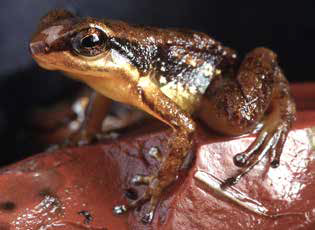
Anomaloglossus breweri is a species of frogs in the family Aromobatidae. It is only known from its type locality, Aprada-tepui in the Bolívar state of southeastern Venezuela. This species was discovered by scientists exploring the inaccessible and remote region of Aprada-tepui. It is a fast-moving frog that lives along creeks and in quiet pools along small streams along the slopes near the cave. The frog is named for Charles Brewer-Carías who collected the type series.

The golden mantella is a small, terrestrial frog endemic to Madagascar. It has an extremely restricted distribution in three distinct areas centered on the town of Moramanga - Beparasy and Ambohibary Communes, Torotorofotsy Wetland northwest of Andasibe, and in the area of Ambakoana. Mantella aurantiaca is one of Madagascar's most threatened amphibian species due to its limited distribution in an area under tremendous anthropogenic pressure. It may also be threatened by over-collection for the pet trade.

The golden poison frog, also known as the golden dart frog or golden poison arrow frog, is a poison dart frog endemic to the rainforests of Colombia. The golden poison frog has become endangered due to habitat destruction within its naturally limited range. Despite its small size, this frog is likely the most poisonous animal on the planet.
The sky-blue poison frog is a species of poison dart frog. It is endemic to Peru and known from the lower eastern versant of the Andes in the upper Amazon basin of the San Martín Region.

Dendrobates is a genus of poison dart frogs native to Central and South America. It once contained numerous species, but most originally placed in this genus have been split off into other genera such as Adelphobates, Ameerega, Andinobates, Epipedobates, Excidobates, Oophaga, Phyllobates and Ranitomeya, leaving only five large to medium-sized species in the genus Dendrobates. All the other genera used to be grouped in with Dendrobates because it was previously thought that all brightly colored poison dart frogs came from the same ancestor but this has since been proven to be incorrect. Dendrobates and Phyllobates evolved conspicuous coloration from the same common ancestor but not the same as any of the other genera listed above.
Hyloxalus cevallosi, also known as Palanda rocket frog, is a species of poison dart frogs in the family Dendrobatidae. It is named after Gabriel Cevallos García, a famous Ecuadorean writer. This species of frog exists on the east side of the Andes in Ecuador near the Pastaza Province as well as the Zamora-Chinchipe Province. Though it has been recorded in Peru, the records have yet to be confirmed. Its natural habitats are very humid premontane and pluvial premontane forests.

Andinobates altobueyensis is a species of frog in the family Dendrobatidae. It is endemic to Alto del Buey mountain in the Serranía del Baudó range, in the Chocó Department of western Colombia. Its common names include Alto de Buey poison frog, golden poison-arrow frog, and golden poison frog.

The blue-bellied poison frog or bluebelly poison frog is a species of frog in the family Dendrobatidae.
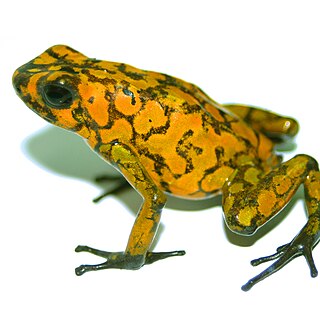
Oophaga sylvatica, sometimes known as its Spanish name diablito, is a species of frog in the family Dendrobatidae found in Southwestern Colombia and Northwestern Ecuador. Its natural habitat is lowland and submontane rainforest; it can, however, survive in moderately degraded areas, at least in the more humid parts of its range. It is a very common frog in Colombia, but has disappeared from much of its Ecuadorian range. It is threatened by habitat loss (deforestation) and agricultural pollution and sometimes seen in the international pet trade.
Silverstone's poison frog is a species of frog in the family Dendrobatidae endemic to Peru. Its natural habitats are subtropical or tropical moist lowland forests and rivers.

The yellow-throated frog, Trinidadian stream frog, or Trinidad poison frog is a diurnal species of frog in the family Aromobatidae that is endemic to the island of Trinidad in the Republic of Trinidad and Tobago. Trinidad poison frogs can be found in rocky streams in moist montane forests. The species has cryptic coloration and is sexually dimorphic. Mannophryne venezuelensis from the Paria Peninsula in Venezuela were also formerly included in this species. Currently this species is listed as of "Least Concern" on IUCN, but there is a general lack of understanding of its distribution. The frog experiences habitat loss. Both sexes are territorial and provide parental care together.

Pumiliotoxin 251D is a toxic organic compound. It is found in the skin of poison frogs from the genera Dendrobates, Epipedobates, Minyobates, and Phyllobates and toads from the genus Melanophryniscus. Its name comes from the pumiliotoxin family (PTXs) and its molecular mass of 251 Daltons. When the toxin enters the bloodstream through cuts in the skin or by ingestion, it can cause hyperactivity, convulsions, cardiac arrest and ultimately death. It is especially toxic to arthropods, even at low concentrations.

Hyloxalus is a genus of poison dart frogs, family Dendrobatidae. The genus is distributed in Central and South America, from Panama south to Peru, along with Venezuela, Colombia, and Ecuador. They also inhabit the eastern foothills of the Andes in Bolivia to Venezuela, east to the upper Amazon Basin.
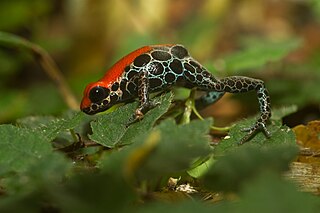
The red-backed poison frog is a species of frog in the family Dendrobatidae. It is an arboreal insectivorous species, and is the second-most poisonous species in the genus, after R. variabilis. Like many species of small, poisonous frogs native to South America, it is grouped with the poison dart frogs, and is a moderately toxic species, containing poison capable of causing serious injury to humans, and death in animals such as chickens. R. reticulata is native to the Amazon rainforest in Peru and Ecuador.
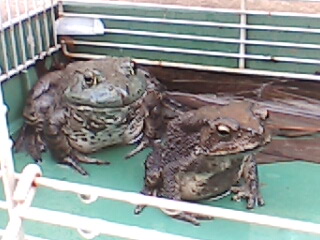
Frogs have recently become very popular exotic pets as they are generally undemanding, often visually appealing, and can be kept under fairly basic conditions. Many frogs, especially common ones, can be inexpensive, but some specimens can cost several hundreds of dollars. Their food is in most cases easily purchased. Commonly kept pet frogs include ranids, hylids, bufonids, leptodactylids, and dendrobatids.
